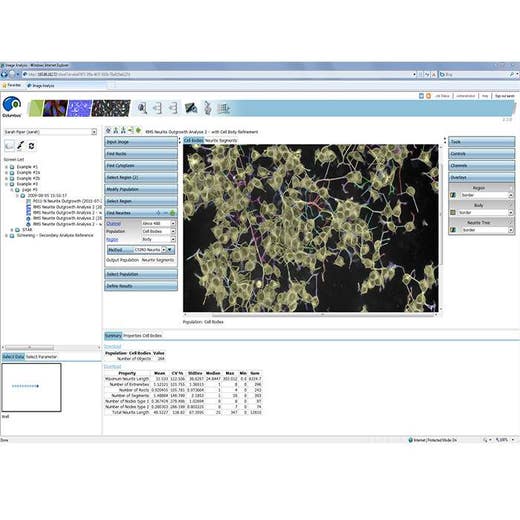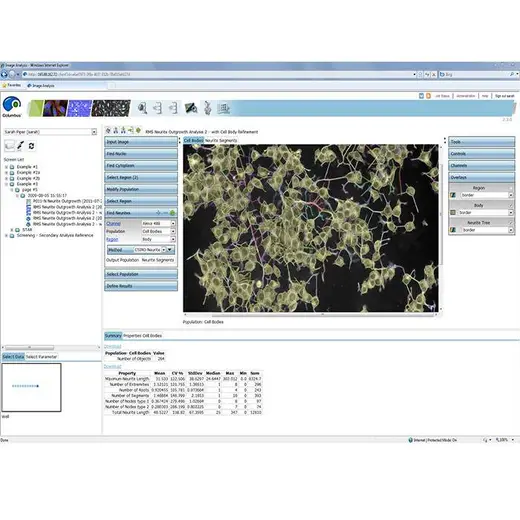
Columbus Plus Image Data Storage and Analysis System



Product information
Overview
The Columbus system has powerful image analysis capabilities with highly flexible and easy to use building blocks to analyze simple and complex phenotypes of cells.
Columbus Plus extends the current Columbus image analysis and management capabilities by offering real-time image analysis utilizing cluster based high performance computing (HPC) with Columbus Building Blocks. Columbus Plus is offered either as an on premise installation, which leverages customer’s internal data center, or as a hosted Cloud service by Revvity.
Image storage and analysis for all your high content imaging data
High Content Screening experiments generate massive amounts of image data that needs to be accessed quickly, analyzed and re-analyzed, shared with colleagues and stored safely. With the trend towards using more complex, physiologically relevant disease models, more sophisticated tools are required to numerically describe cells and their phenotypes comprehensively. The Columbus system is the only image data storage and analysis system that supports a wide range of file formats, allowing visualization of images, regardless of their origin.
Columbus Building Blocks
- Import images from any major high content imaging instrument for a single solution for data storage and analysis.
- Utilize powerful image analysis building blocks that are easy to use and have been designed to be used by researchers, not just image analysis experts
- Analyze new images or re-analyze images from past experiments using our building blocks which encapsulate our many years of experience in high content analysis
Machine learning – improve hit selection rates
- Access your Columbus results directly in High Content Profiler, powered by TIBCO Spotfire®, and perform screening data analysis and validation, QC analyses, calculate reliable normalization, perform multivariate hit stratification and drug response profiling.
- Utilize pre-designed segmentation routines and feature extraction algorithms, such as STAR morphology, to perform sophisticated analysis with ease.
- Compare multiple samples, plates or batches to quality check your results
- Relate results to concentrations with dose response curves
- Columbus system enables access to data from the convenience of your web browser. Researchers can store all image data in a central location, with associated metadata to give a complete and enduring picture of any experiment.
Ultra-performance – more screens
The segmentation of high resolution images to identify individual cells or regions in tissues followed by state-of-the-art cell quantification (morphology, texture, intensity statistics, etc.) takes hours (single plates) or even weeks or months when using conventional computing systems on large screens. To enable reasonable analysis time even when working with large screens of data, Columbus Plus utilizes HPC systems to solve that problem. HPC refers to the practice of aggregating computing power in a way that delivers much higher performance than one could get out of a typical desktop computer or workstation. In a cluster of many computing nodes, wells from microtiter plate are analyzed in parallel. Hence the total analysis time of multi-well plate (commonly 96, 384 and 1536) scales with the number of computing nodes available. To avoid conflicting access of image files, all individual nodes are connected to a high performance file system.
Columbus Plus supports the most common used job schedulers (SGE and Spark) to distribute the well based image analysis to the available computing nodes. Columbus Plus provides the high performance batch analysis of entire screens with just one mouse click.
Multi-Parametric Data Analysis – more features can be analyzed
One of the key challenges for High Throughput Screening (HTS) is that identified hits in the screens showed a very high failure rate in secondary toxicology screens. Only a few (2-3) parameters of the HCS screen were analyzed. Toxicology parameters were not taken into account for the hit profiling. HCS however promises to provide significantly better quality with biologically relevance results. The more parameters extracted from an image the better the quality if the profiling is done properly (e.g. with Revvity High Content Profiler). With significant reduction in image analysis time from days to hours, leveraging Columbus Plus’ industry leading Building Blocks for image analysis and PhenoLOGIC™ machine learning technology, will enable scientists to collect more cellular features without sacrificing or delaying project timelines, therefore increasing the data quality for profiling analysis.
Specifications
| Brand |
Columbus Plus
|
|---|---|
| Unit Size |
1 Each
|
Resources
Are you looking for resources, click on the resource type to explore further.
Mitochondria are complex networks that are highly variable, both between cell lines and within cell populations. Reliably...


How can we help you?
We are here to answer your questions.






























